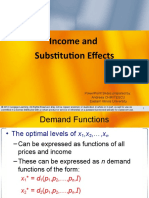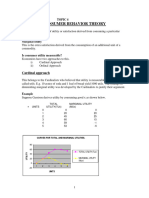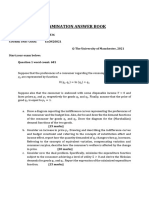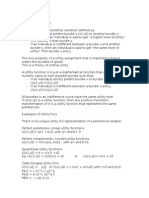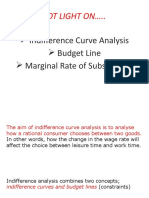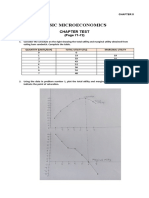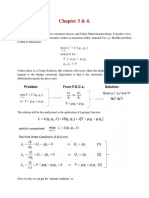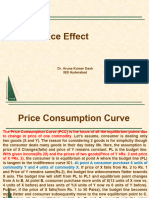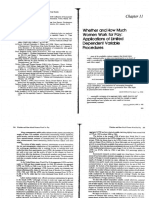Cobb Douglas Utility Function Questions
Uploaded by
huda.rauf781Cobb Douglas Utility Function Questions
Uploaded by
huda.rauf781Intermediate Microeconomics Assignment
SUBMITTED BY: SUBMITTED TO:
Alina Noor (427522) Ma’am Ayesha Javed
Noor ul Huda Rauf (408582)
Shehrbano Hussain (407910)
BS ECONOMICS 22
Section B
Economics Questions: Cobb-Douglas Utility Function
1. Marginal Utility: Calculate the marginal utility of good x and good y for the utility
0.5 0.5
function U(x, y) = 𝑥 𝑦 . How does the marginal utility change as the
consumption of either good increases?
Answer:
Marginal Utility of a commodity is the rate of change of total utility, as the quantity of the
commodity consumed changes.
Marginal Utility of good x: MUx = ∂U/∂x = 0.5x-0.5y0.5
As the consumption of good x increases, the marginal utility of good x decreases.
Marginal Utility of good y: MUy = ∂U/∂y = 0.5x0.5y-0.5
As the consumption of good y increases, the marginal utility of good y decreases.
2. Marginal Rate of Substitution (MRS): Derive the formula for the MRS for this
utility function. Calculate the MRS when x = 10 and y = 10. What does this tell you
about the consumer's willingness to trade one good for the other?
Answer:
Marginal Rate of Substitution refers to the rate at which a consumer can give up an
amount of one good for another good, all the while maintaining the same amount of
utility or satisfaction. It is the ratio of the MU of one good to the MU of another.
MRS= MUx/MUy
Derivation of Marginal Rate of Substitution:
∂U/∂X (dx) + ∂U/∂Y (dy) = 0
∂𝑈 ∂𝑈
∂𝑌
(dy) = - ∂𝑋 (dx)
−∂𝑈/∂𝑥
dy/dx = ∂𝑈/∂𝑌
𝑦
MRS= - 𝑥
Substitute the previously calculated values in this formula:
0.5 • 𝑥−0.5 • 𝑦0.5
MRS= − 0.5 • 𝑥0.5 • 𝑦−0.5
𝑦0.5
MRS= – 𝑥0.5
𝑦
MRS= − 𝑥
y=10 x=10
10
MRS𝑥𝑦 = − 10
MRS𝑥𝑦 = -1
This MRS suggests that the consumer is indifferent between the two goods. The
consumer remains equally satisfied when exchanging one good for another. Both goods
are valued equally.
3. Ordinary Demand and Price Offer Curves: Assuming the prices of x and y are Px
and Py respectively, and the consumer's income is I, derive the demand functions
for x and y. Consider Px = 1, Py = 2, and I = 20. How do the demand curves for x
and y change as Px varies while Py and I remain constant?
Answer:
4. Income Offer Curves and Engel Curves: Derive the income offer curve for this
utility function. Plot the Engel curve for good x assuming Px and Py are constant.
How does the quantity of x demanded change with varying income levels?
Answer:
If p(X) increases the consumer will consume less of it. consumers tend to demand less
of a good when their prices increase. The demand of Y good can increase in this case.
If p(X) decreases the consumer will get more of a good x. The demand for good x
increases. The demand for products with lower price increases.
5. Slutsky Equation: Explain the Slutsky equation in the context of this utility
function. Graphically illustrate the substitution and income effects for a price
change in good x. How do these effects contribute to the overall change in
quantity demanded?
Answer:
The Slutsky equation is an economic concept named after Eugen Slutsky. It is a
fundamental result in consumer theory and helps analyze the effects of price changes on
the quantity demanded of a good. The Slutsky equation decomposes the total effect of a
price change into two components: the substitution effect and the income effect.
In this utility function we have U (x,y) = x 0.5 y 0.5 where x and y are the quantities of the 2
goods with their respective prices at px and py. The budget constraint will be
Px.X + Py.Y = I (where I = income)
Considering the change in the price of good x,we assume that the price of x decreases
from Px to Px’
Substitution Effect:
Slutsky assumed that at new prices, the consumer can just only buy the original bundle
so that the effect of only the change in relative prices on demand can be observed.
Lower prices of good x will cause the budget constraint to pivot outwards along the x
axis as people will now be able to afford more of good x at the given income. As good x
becomes cheaper, consumers substitute it for now relatively more expensive other
commodities i.e. y. Demand of x increases from x’ to x” and y decreases from y’ to y”
Income Effect:
Due to lowered prices of x, the consumer's budget of $I can purchase more than before
as if the consumer's income rose with consequent income effects on quantities
demanded.
For graphical analysis, we assume that the price of good x decreases. (x’,y’) to (x”,y”)
shows the pure substitution effect while (x”,y”) to (x”’,y”’) shows income effect. The
change in demand due to lowered prices is a sum of both these effects i.e. (x’,y’) to
(x”’,y”’). The overall quantity demanded for good x increases and for good y decreases.
6. Graphical Analysis: Draw the indifference curve for the utility level U = 10. On
the same graph, illustrate the budget constraint given Px = 1, Py = 2, and I = 20.
Identify the optimal consumption bundle.
Answer:
You might also like
- Instant Download Intermediate Microeconomics A Modern Approach Media Update 9th Edition Hal R. Varian PDF All Chapters100% (1)Instant Download Intermediate Microeconomics A Modern Approach Media Update 9th Edition Hal R. Varian PDF All Chapters65 pages
- Get (eBook PDF) Microeconomics For Today 9th Edition by Irvin B. Tucker free all chapters100% (2)Get (eBook PDF) Microeconomics For Today 9th Edition by Irvin B. Tucker free all chapters41 pages
- ECO 211 TOPIC 4 Consumer Behavior TheoryNo ratings yetECO 211 TOPIC 4 Consumer Behavior Theory12 pages
- Microeconomics Income and Substitution EffectsNo ratings yetMicroeconomics Income and Substitution Effects3 pages
- MathematicalEconomics Lecture1 6 2014 PDFNo ratings yetMathematicalEconomics Lecture1 6 2014 PDF102 pages
- EC 2101: Microeconomic Analysis I: Kwong-Yu WongNo ratings yetEC 2101: Microeconomic Analysis I: Kwong-Yu Wong66 pages
- 1st Assignment for IA Intermediate MicroeconomicsNo ratings yet1st Assignment for IA Intermediate Microeconomics2 pages
- BAB 5 - Jawaban Eko Manajerial Theory of Consumer Behavior100% (1)BAB 5 - Jawaban Eko Manajerial Theory of Consumer Behavior14 pages
- The Consumer's Optimization Problem: - Individual Consumption Decisions Are Made With The Goal of FromNo ratings yetThe Consumer's Optimization Problem: - Individual Consumption Decisions Are Made With The Goal of From33 pages
- SPOT LIGHT On-Indiff Curve, Budget Line...No ratings yetSPOT LIGHT On-Indiff Curve, Budget Line...18 pages
- Indifference Curve Analysis and Demand Curve83% (6)Indifference Curve Analysis and Demand Curve4 pages
- c.7.f. The Compensating and Equivalent Variations Applied To Demand CurvesNo ratings yetc.7.f. The Compensating and Equivalent Variations Applied To Demand Curves4 pages
- Indifference Analysis: Background To DemandNo ratings yetIndifference Analysis: Background To Demand86 pages
- Notes and Exercise 3-4-In - Microeconomics PyndicNo ratings yetNotes and Exercise 3-4-In - Microeconomics Pyndic13 pages
- Principles of Microeconomics 12th Edition Case Solutions Manual pdf download100% (1)Principles of Microeconomics 12th Edition Case Solutions Manual pdf download49 pages
- Notes_2950_Price Income and Substitution Effect (Hicks and Slutsky)No ratings yetNotes_2950_Price Income and Substitution Effect (Hicks and Slutsky)9 pages
- Immediate download Microeconomics 3rd Edition Hubbard Test Bank all chapters100% (7)Immediate download Microeconomics 3rd Edition Hubbard Test Bank all chapters70 pages
- WBCS Optional Paper ECONOMY 18 Years (2000-2017)No ratings yetWBCS Optional Paper ECONOMY 18 Years (2000-2017)39 pages
- Module 1: Consumer Choice Theory & Behaviour Chapter 1: Demand ConceptsNo ratings yetModule 1: Consumer Choice Theory & Behaviour Chapter 1: Demand Concepts26 pages
- Part 2 Chapter 4 Economic Principles Summary Lecture 5 Week 3No ratings yetPart 2 Chapter 4 Economic Principles Summary Lecture 5 Week 315 pages
- (eBook PDF) Microeconomics, Global Edition 8th Edition, by Jeffrey M. Perloff download100% (2)(eBook PDF) Microeconomics, Global Edition 8th Edition, by Jeffrey M. Perloff download56 pages
- caie-a2-level-economics-9708-theory-643eb3151d569d408b06dc09-029 copyNo ratings yetcaie-a2-level-economics-9708-theory-643eb3151d569d408b06dc09-029 copy22 pages
- UNIT 2 THEORY OF CONSUMER BEHAVIOUR BBA 2 ND Part Microeconomics 2n Sem Pokhara University NEWNo ratings yetUNIT 2 THEORY OF CONSUMER BEHAVIOUR BBA 2 ND Part Microeconomics 2n Sem Pokhara University NEW66 pages
- Decomposing The Slutsky Decomposition For The FirsNo ratings yetDecomposing The Slutsky Decomposition For The Firs9 pages
- (eBook PDF) Economics for Today 10th Edition by Irvin B. Tucker downloadNo ratings yet(eBook PDF) Economics for Today 10th Edition by Irvin B. Tucker download58 pages
- Distance Learning Midterm Examination 1 Semester - 2020/2021 Microeconomics 2 (ECEU600101)No ratings yetDistance Learning Midterm Examination 1 Semester - 2020/2021 Microeconomics 2 (ECEU600101)5 pages
- Labour Economics (BSC) - Fall 2019 ExamNo ratings yetLabour Economics (BSC) - Fall 2019 Exam10 pages










